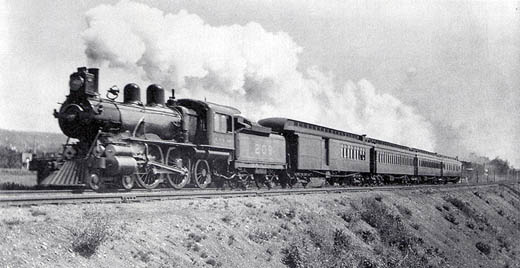 |
Spring 2007
|
Just About the Fastest Things on
Earth: CPR's
4-4-2 Atlantics
STEEL WHEELS by Corporate Historian Emeritus Jonathan
Hanna

Competition with Car: The
locomotives raced along the Montreal-Ottawa corridor.
Man has always been fascinated
with speed. And, toward the end of the 19th century, man's thirst for speed was quenched by a dynamic duo - steam
locomotives and railways.
In North America, the big record breaking moment came on 11 May 1893. New York Central's locomotive No.
999 broke the magical 100-mile-per-hour ( 160-km/h ) speed barrier in Crittenden West, New York. The
Guinness Book of World Records says that this speed record was never officially verified. Still, mankind was amazed
at how fast it could travel with the help of its man-made machines - 112.5 mph ( 181 km/h ) to be exact.
It took until 1936 for Canadian Pacific Railway ( CPR ) to equal this speed record.
CPR got the speed bug at the tail end of the 19th century. So the railway went to work on some of its own
man-made speed makers. CPR wasn't exactly worried about how fast the New York Central ( NYC ) could go.
It was more concerned with its local competition - the Canada Atlantic Railway.
Once the CPR had completed its 1898 "short line" between Montreal and Ottawa via Van Kleek Hill, Ontario,
it could now take on its Ottawa-service rival - the Canada Atlantic Express - that ran between the
capital city and the country's then-metropolis. Both the Canada Atlantic and the CPR emulated NYC's No.
999-type of locomotive. Canada Atlantic out-sourced its speed quest to the Baldwin
Locomotive Works of Philadelphia, and took delivery of three 4-4-2 Atlantic locomotives in 1899. CPR
relied on its own ingenuity, using a design from CPR mechanical engineer A.W. Horsey, under chief mechanical officer
H.H. Vaughan's direction, to build three 4-4-2 Vauclain-system, compound steam locomotives
with huge 84-inch ( 213-cm ) drivers.
These driving wheels were the largest ever installed on CPR locomotives. They were built a whole foot taller than a
6-foot man, so that the locomotives could reach triple-digit speed. CPR's three
4-4-2 Atlantic type locomotives were actually more like 4-6-0 locomotives, because their
trailing axle was not independent but mounted onto a rigid frame. They were numbered 209 to 211, and
out-shopped in July 1899 from the company's DeLorimier Works in Montreal.
Their Vauclain high-pressure cylinders exhausted live steam into a second set of lower pressure
cylinders. This helped the locomotives go as fast as the roadbed would allow, and also cut down on fuel consumption.
But this complicated system was hard to maintain, and 10 years later the locomotives were converted to simple systems
and renumbered.
In their heyday, however, the locomotives raced along the Montreal-Ottawa corridor
neck-to-neck with the competition's Canada Atlantic Express. Thomas Shaughnessy, CPR's
by-the-book president, called one Montreal-Ottawa locomotive engineer "on the
carpet". He sternly warned him: "There will be no more speeding on this railway." He then
added: "But don't let the other guy win, either".
All three locomotives were scrapped in 1917, as conventional CPR locomotives Nos. 2150 to 2152.
| |
Vital Statistics
|
Locomotive Numbers
|
209-211 ( 1899-1909 )
1000-1002 ( 1909-1910 )
950-952 ( 1910-1913 )
2150-2152 ( 1913-1917 )
|
Class
|
ST4 ( later F1a and F1b )
|
Builder
|
CPR DeLorimier Shops
|
Out-shopped
|
July 1899
|
Type
|
Atlantic
|
Wheel arrangement
|
4-4-2
|
Tractive effort
|
25,900 lbs (11,750 Kg)
|
Driving wheel diameter
|
84 in. (213 cm)
|
Extreme length
|
63 ft. 9 in. (19.4 m)
|
Extreme Height
|
15 ft. 2 in. (4.6 m)
|
Weight loaded
|
275,250 lbs. (124,850 Kg)
|
This Momentum article is copyright
2007 by the Canadian Pacific Railway and is reprinted here with their
permission. All photographs, logos, and trademarks are the property of the Canadian Pacific Railway
Company.
|